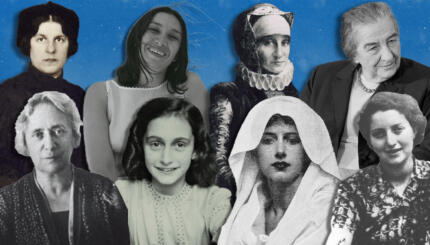As someone who is involved in Jewish LGBT work, I am often surprised people tell me that they had no idea that we Jews have queer clergy. Not only are we very proud of the work they do, but they’ve also been around (openly, anyway) for over a quarter century
!
With this post, we’re launching a new column spotlighting a lesbian, gay, bisexual, or transgender rabbi or cantor. This behind-the-scenes look at queer clergy will cover both those who have paved the way, and those who are the up-and-coming trailblazers. It can be hard to come out, and it can be especially risky for those who are, or aspire to be, clergy. Nonetheless, this vanguard has helped open up the Jewish world, and we’re very excited to shine an extra light on their work, their ideas, and their stories.
In 1999, Rabbi Steve Greenberg became the first out Orthodox rabbi. Five years later, Rabbi Greenberg published Wrestling with God and Men: Homosexuality in the Jewish Tradition, a book that is not only an new look at depictions of same-sex relationships in Jewish sacred texts, but also examines these relationships in Jewish poetry and case law.
We’re proud to partner with Rabbi Greenberg in his work to bring full inclusion to the full spectrum of the Jewish community.
How has being gay informed your work as a rabbi?
I’m not sure being gay informs anything. It conditions things. It conditioned my growing up in a way that was sometimes scary, and very often confusing and alienating—as in making me feel like an alien in my own family and community.
For some people the experience of alienation leads to spiritual searching, for others it does not. For me, it did. Seeking a haven in ancient books, in a “child of a survivor” historical consciousness, and in God made perfect sense when I didn’t feel so at home in the world. While it was not the only cause for my budding interest in Torah study, the promise of a world very different from the All-American hyper-hetero teen world of the 1970s was surely part of my story.
My decision to become a rabbi was all about my love of the learning and the living realities of a religious community. I was able to sublimate and not really attend to my inner life for years. When I was twenty and in a yeshiva in Israel I could no longer deny the power of my feelings. Confused and scared, I went to a Haredi rabbi, the recently passed posek (high-level decisor of Jewish law), Rav Yosef Shalom Eliashuv. Quite surprisingly, he calmed me and gave me hope by describing my illicit desires as a power of love. I felt at the time I was bisexual enough to make a life with a woman. For fifteen years I dated women hoping this is what would happen. Once the fantasy of this way out evaporated, I realized that my gayness was either going to end my rabbinic career or shape it. I chose the latter.
How has it shaped it? Well, it has made me aware of the costs of some forms of traditional thinking. No doubt it has made me more open to women’s issues and far more interested in the silenced voices generally. In practice it has shaped my rabbinate by creating a focus not merely on ideals, but on the real-world applications that matter. Being known as a gay Orthodox rabbi is limiting at times but it most often feels like an incredible gift.
What should we, as members of the LGBT Jewish community, be focusing on now?
That’s easy. In my view, two things—integration and mutual education. Integration: How do we make ourselves a part of the community rather than a critique of it. It’s no simple matter for a community defined by reproduction (Jesus makes disciples; Abraham and Sarah make a baby) to find a way forward for gay folks. Integrating gay people into the fabric of Jewish family life is happening today more than ever, helping young gay people see possibilities that weren’t available a decade ago.
Education means we need to learn and teach our Torah. What does queerness demand of Judaism and what can Jewishness demand of us queer folk? It is our moment’s calling to determine how
kedushah
(holiness) can be applied and extended to us, how our less-binary reality can be mapped onto a world living in that reality.
Favorite queer Jewish figure?
It’s hard to choose one. Esther’s courage to say the truth about her identity in a context that could cost her life comes to mind. Maybe my two queer favorites are two religious poets who both wrote poems about their love of men, Moshe Ibn Ezra and Yehudah HaLevi.
What’s next for you? A project, a sermon—what are you working on that’s queer and Jewish?
I am part of a community of religious queer Jews called Eshel. We are creating retreats for community building, supporting people to trust their own voices, and urging them to speak respectfully and effectively to their rabbis and communities by simply sharing their stories. The world is opening up slowly as we are understood not as aggressive spoilers, but as fellow Jews, sons, daughters, students and teachers, who are seeking a place at the table.
Torah
Pronunced: TORE-uh, Origin: Hebrew, the Five Books of Moses.


